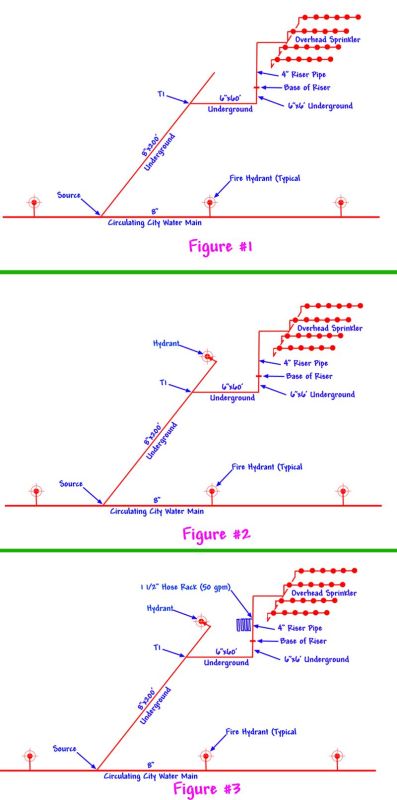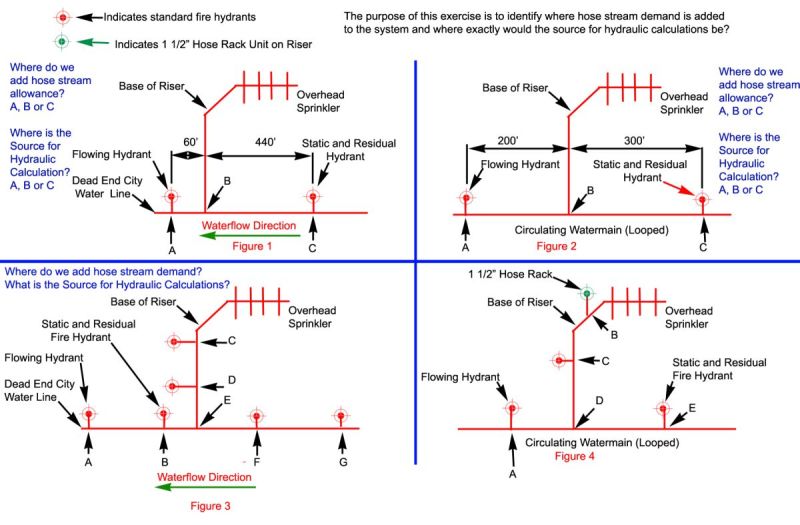Sergiosldv
Mechanical
Hello, good day.
I have some questions that confusesme.
1- A couple of engineers toldme that they always use 500 gpm vs XXX psi and the system always is "right".
I have seen that when you calculate your design, and you have something like 250 gpm vs XXX psi, then for any reason they add 250 gpm to the design, i mean, i know that the code says that you should add 250 gpm in 60-90 min (ordinary risk) if you have external and internal hidrants, but if i calculate my pipe's diameter for 250 gpm (which are going to go to the sprinklers), what do i do with the other 250 gpm? where are they going? are they going to flow to the last sprinkler? are those gpm going to change the preassure in every sprinklers of my design area?. do i have to resize the pipes?
2- When i calculate a sprinklers system by the area/density method, and i want to add a hose flow to the main pipe, the code says that a hose should have a minimun residual preassure of 65psi. I always think that i will add 65 psi to the preassure loss in the system and obviously the 50 gpm of the hose, i dont know if that way is correct. ie: my design area gives me 225gpm vs 20 psi until the connection with the hose, so should i just add 50 gpm to the water flow, and 65 psi to my total preassure lost until there? a work the rest of the pipe with 275 gpm with 85 psi and add the rest of the preassure lost in the rest of the pipe until the pump.
3- some examples and calculations that i have seen never includes the preassure lost in the pump's suction area, is that correct? i havent finded anything in the codes about considerations of suction.
Thank you
I have some questions that confusesme.
1- A couple of engineers toldme that they always use 500 gpm vs XXX psi and the system always is "right".
I have seen that when you calculate your design, and you have something like 250 gpm vs XXX psi, then for any reason they add 250 gpm to the design, i mean, i know that the code says that you should add 250 gpm in 60-90 min (ordinary risk) if you have external and internal hidrants, but if i calculate my pipe's diameter for 250 gpm (which are going to go to the sprinklers), what do i do with the other 250 gpm? where are they going? are they going to flow to the last sprinkler? are those gpm going to change the preassure in every sprinklers of my design area?. do i have to resize the pipes?
2- When i calculate a sprinklers system by the area/density method, and i want to add a hose flow to the main pipe, the code says that a hose should have a minimun residual preassure of 65psi. I always think that i will add 65 psi to the preassure loss in the system and obviously the 50 gpm of the hose, i dont know if that way is correct. ie: my design area gives me 225gpm vs 20 psi until the connection with the hose, so should i just add 50 gpm to the water flow, and 65 psi to my total preassure lost until there? a work the rest of the pipe with 275 gpm with 85 psi and add the rest of the preassure lost in the rest of the pipe until the pump.
3- some examples and calculations that i have seen never includes the preassure lost in the pump's suction area, is that correct? i havent finded anything in the codes about considerations of suction.
Thank you


